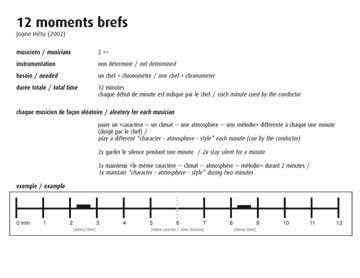
Joane Hétu
12 moments brefs
Listen to 12 moments brefs. Written by Joane Hétu. Recorded in concert on Sept. 10, 2007 in Montréal by Joane Hétu. Peformed by Jean Derome (soprano saxophone, objects and vocals), Joane Hétu (alto saxophone and vocals), Diane Labrosse (sampler), Danielle Palardy Roger (percussions), Pierre Tanguay (drums), Martin Tétreault (turn-tables).

With 12 Moments brefs (2000), Joane Hétu’s intention was to compose a piece that would work with any ensemble of two or more players and for any instrumentation. The piece is an étude of time, which, according to Hétu, is the most challenging aspect of improvised musical practice. By emphasising the potential for a multitude of possible perspectives in a one minute interval of time, the strength of the piece lies in the contrasts between the perspectives that emerge over the course of a given performance.
Intervals
The one minute interval is a particularly idiosyncratic duration, as it can be perceived as both relatively long or short depending on the nature of the musical activity taking place. Moreover, the moments of rupture, when the players move from one minute-long episode to the next, are exciting and intense, because in a very short period, all the musicians change their musical materials simultaneously.
Responding to the Moment
12 Moments brefs is structured in terms of twelve one minute episodes or “moments” played in succession, where the change from one episode to the next is cued by a director. After having tried longer and shorter overall durations, Hétu decided that the twelve minute overall duration was long enough to be challenging for the players in terms of maintaining the flow, but not so long that the audience loses interest. The players are confronted with the challenge not only of measuring time accurately, but also of sculpting a brief interval of time in a meaningful way. Given the relative brevity of a given episode, there is time enough for a single spontaneous idea to be stated and sustained for the one minute duration. The piece hinges primarily on the ability of every player to respond to the moment on impulse, and thus the degree of risk is very high. For instance, one obvious risk involves the continuity of a given episode, given that no one knows in advance what the other players will play. There are two variables that further nuance the piece. The first consists of two episodes of silence that must be observed ad libitum by every player over the course of the piece. This ensures variations in the instrumentation over the course of a performance. The second consists of one instance that must be observed by every player, again ad libitum, in which the material from one episode is sustained through the next.
The Score
As the piece is structured conceptually rather than notationally — the score consists of a single page of very brief instructions which can be memorized quickly — it is easy to understand and compelling for the players. Hetu has successfully transposed this piece over several performances in various contexts with improvisers of different ages and skills.
 English |
English |